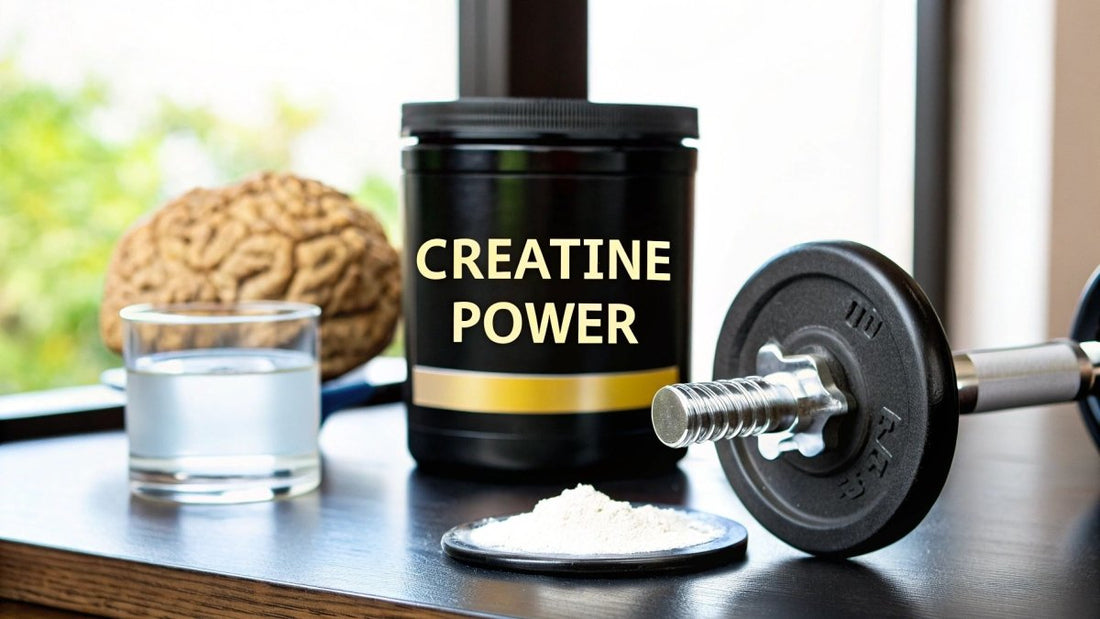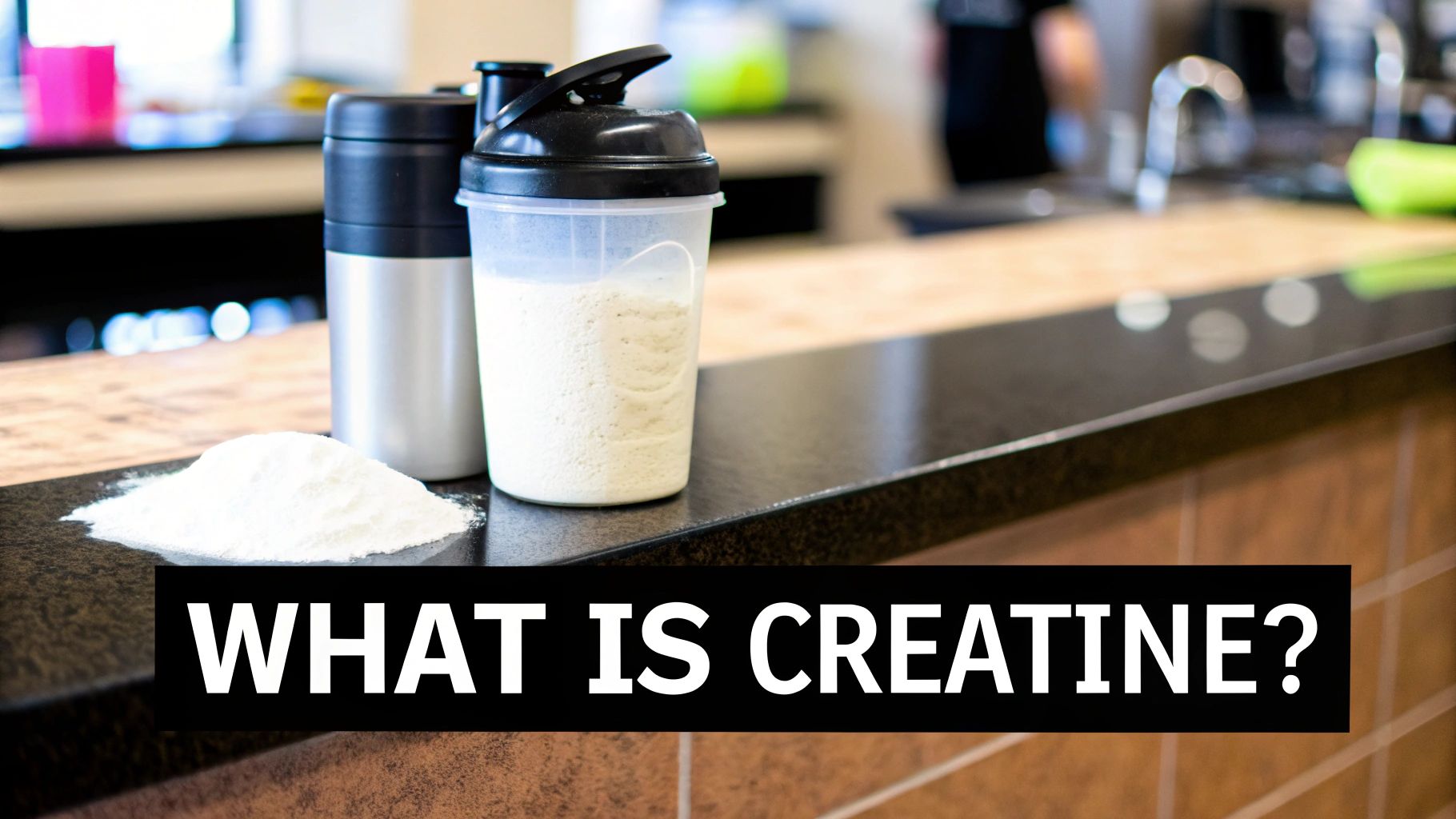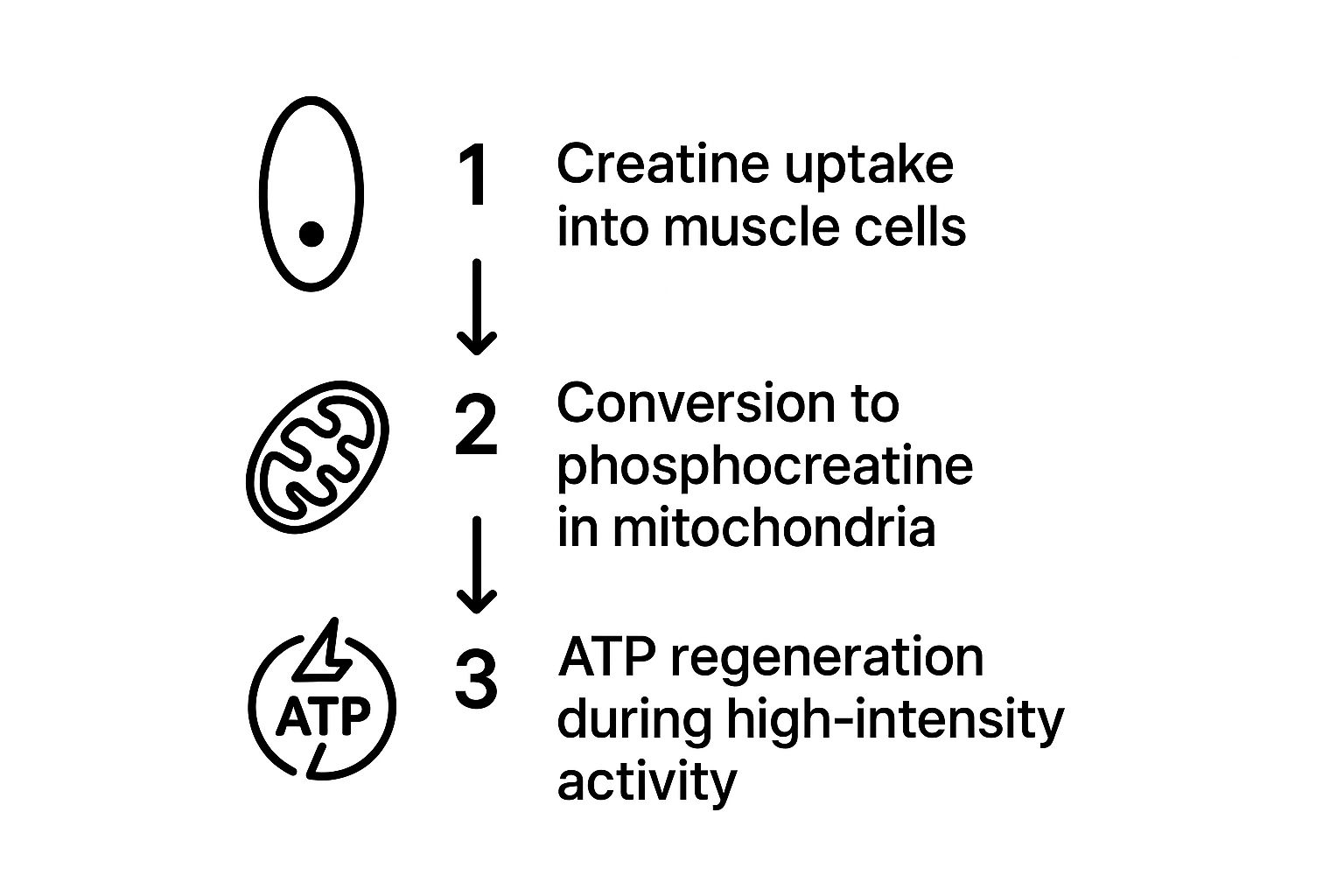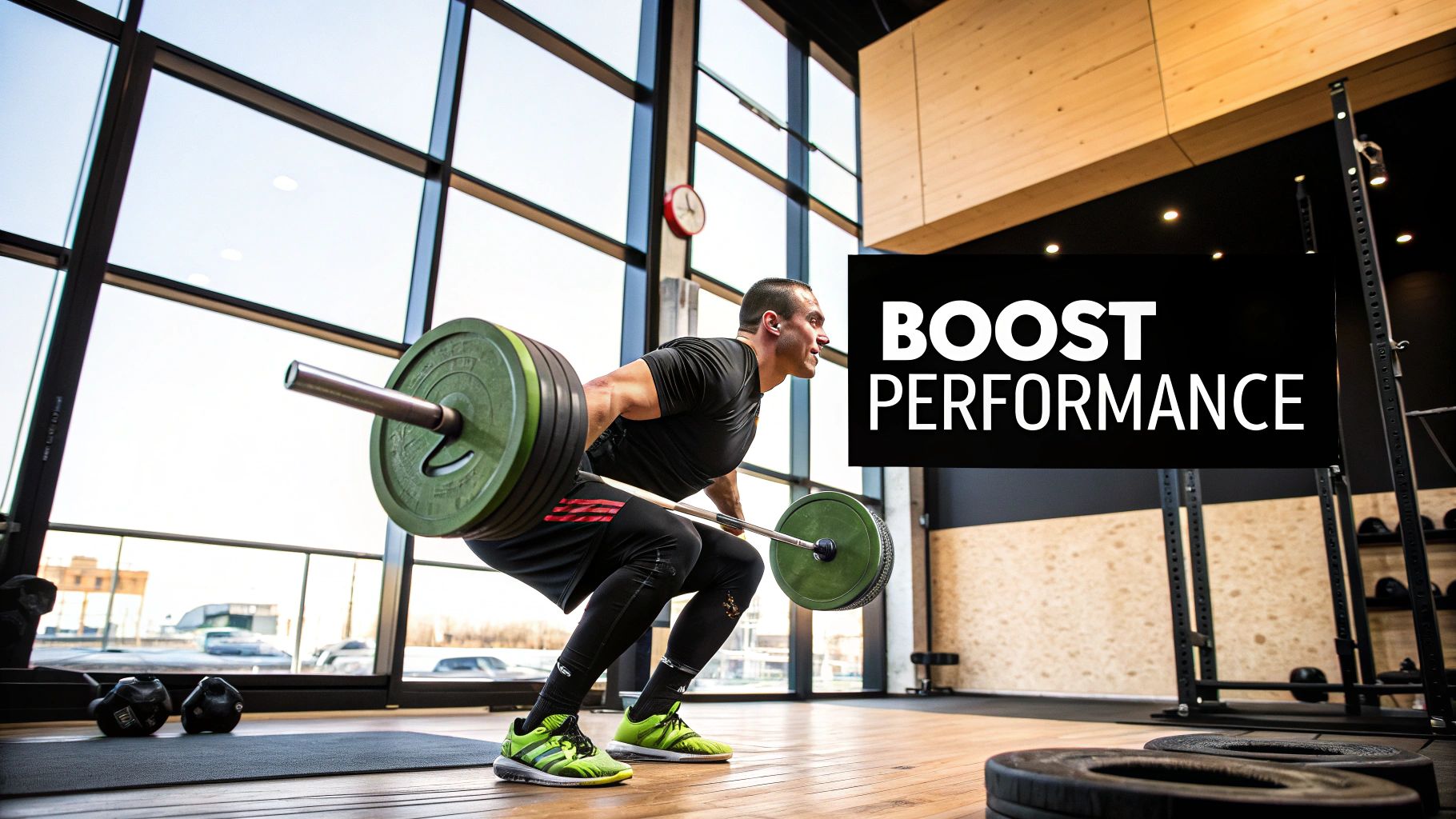
What Does Creatine Do? Benefits for Muscle, Brain & Recovery
Share
Let's cut right to the chase. Creatine is your body's express lane for energy, especially when you're doing intense, short-burst activities like lifting weights or sprinting. Imagine your main muscle fuel, a molecule called ATP, is like a phone battery that dies after just a few seconds of heavy use. Creatine swoops in like a portable power bank, instantly plugging in to refuel that battery so you can keep pushing.
What Does Creatine Actually Do For Your Body

To really get what creatine does, we need to zoom in from the gym floor to the cellular level. Creatine is a compound your body makes naturally from three amino acids: L-arginine, glycine, and L-methionine. You produce about one gram of it every day, and you also get a bit from foods like red meat and fish.
But here’s the thing: that natural supply usually isn't enough to fully load up your muscles and unlock your true performance potential. This is where supplementation makes a huge difference, giving you a concentrated dose to top off those internal energy tanks.
More Than Just Muscle Fuel
While it’s famous for fueling athletic performance, creatine’s benefits are surprisingly far-reaching. It acts as an energy shuttle not just for your muscles, but also for your brain—one of the most energy-hungry organs you have.
This wide-ranging impact means its effects go way beyond just lifting heavier. By making sure your cells have instant energy on tap, creatine supports a whole host of critical bodily functions.
Creatine’s core mission is to rapidly regenerate adenosine triphosphate (ATP), the universal energy currency of your cells. This process is essential for everything from a powerful squat to complex problem-solving.
This gives you a clear, practical answer to what's happening under the hood. Now, let’s get into exactly how this process powers up your performance, sharpens your mind, and even helps you recover faster.
Creatine's Core Functions At a Glance
To simplify things, think of creatine as a multi-talented player in your body. This table breaks down its main jobs in different areas, giving you a quick snapshot of why it's so effective.
| Area of Impact | Primary Function | Key Benefit |
|---|---|---|
| Muscles | Rapidly regenerates ATP for explosive energy | Increased strength, power, and workout volume |
| Brain | Supports cellular energy in neurons | Enhanced short-term memory and mental clarity |
| Recovery | Reduces muscle cell damage and inflammation | Less soreness and faster return to training |
| Cell Hydration | Pulls water into muscle cells (volumization) | Supports muscle growth signals and hydration |
As you can see, from powering your lifts to clearing up brain fog, creatine is a powerhouse supplement that works on multiple fronts to help you perform at your best.
How Creatine Fuels Your Body's Energy System
To really get what creatine does, we need to forget the gym for a second and zoom in—way in—to the microscopic world inside your cells. Every single thing you do, from blasting through a heavy squat to just blinking your eyes, is fueled by a molecule called adenosine triphosphate (ATP).
Think of ATP as your body’s universal energy currency. It’s the cash your cells spend to get anything done.
But here’s the catch: your body is incredibly stingy with this stuff. Your muscles only keep enough ATP on hand for about 2-3 seconds of all-out, maximum effort. That’s it. Just enough for the first explosive step of a sprint or the initial heave of a deadlift. After that, your performance would hit a wall unless that ATP could be regenerated on the spot. This is where creatine becomes the hero of the story.
The Ultimate Energy Recycling System
When your body "spends" an ATP molecule, it loses a phosphate group and turns into adenosine diphosphate (ADP). You can think of ADP as a dead battery—it's useless for powering anything on its own. Your body needs a super-fast way to slap that third phosphate back on and recharge it into ATP.
This is creatine's primary job. Most of the creatine in your body isn’t just floating around; it's stored in your muscles as phosphocreatine (PCr). Imagine phosphocreatine as a bunch of tiny, pre-loaded power packs specifically designed to recharge those dead ADP batteries instantly.
This whole lightning-fast process is called the ATP-PCr system, and it works like this:
- You Explode into Action: You perform a powerful movement, and your ATP is spent, becoming ADP.
- Creatine Jumps In: A phosphocreatine molecule immediately swoops in and donates its phosphate to that "dead" ADP.
- Energy Is Restored: Bam! The ADP is instantly recycled back into a fresh, fully charged ATP molecule, ready to fuel your very next rep.
This near-instantaneous recycling is what allows you to push through high-intensity efforts for longer than a mere couple of seconds. It extends that window of peak power from 2-3 seconds up to around 10-15 seconds before your body has to switch to slower, less efficient energy systems.
Analogy: The Instant Cash Transfer: Think of ATP as the cash you have in your wallet—it’s great for immediate purchases, but you only carry a few bucks. Once that’s gone, you're stuck. Phosphocreatine is like having a pre-approved, instant cash transfer linked directly to your wallet. The second your cash runs out (ADP), the transfer hits (PCr donates), and your wallet is full again (ATP). You can keep going without missing a beat.
This infographic breaks down that simple but powerful three-step process.

As you can see, supplementing with creatine tops off your phosphocreatine stores, which directly powers a more efficient ATP recycling system when you’re training hard.
Why Supplementation Matters for Energy
Sure, your body makes a little creatine on its own, but it’s not nearly enough to fully saturate your muscles. By taking a creatine supplement, you can boost your phosphocreatine reserves by as much as 20-40%.
A bigger fuel tank means your body can crank out ATP faster and for longer during intense exercise.
And this isn’t just for bodybuilders. This rapid-fire energy system is vital for any activity that demands short, powerful bursts. For athletes in sports that require repeated sprints or explosive movements, having more readily available energy is a total game-changer. Even endurance athletes can tap into this system for a final kick to the finish line—you can learn more about that here: https://smash.com/blogs/smash-com-blog/creatine-for-endurance-athletes.
While creatine is busy fueling those powerful muscle contractions, it’s also smart to support your overall vitality from all angles. Exploring natural ways to boost energy levels can create a great foundation for daily life, perfectly complementing creatine's targeted performance benefits. By putting it all together, you feel energized both inside the gym and out.
Boosting Athletic Performance and Muscle Growth
So, we've covered the science of how creatine works like a rapid recharger for your cells. Now, let's get to the good stuff: what does that actually mean for your performance in the gym and the results you see in the mirror?
It all comes down to this: by giving your muscles a steady, on-demand supply of ATP, creatine lets you push harder and go longer. It’s the difference between failing on that eighth rep and confidently pushing out a ninth or tenth. That extra effort—that higher training volume and intensity—is precisely what signals your muscles that they need to adapt, grow, and get stronger.

Driving Strength and Power Output
Remember that ATP-PCr system we talked about? It's your body's go-to energy source for short, explosive movements. Supercharging this system with creatine pays off big time in any activity where power is the name of the game.
For anyone lifting weights, this translates directly to a stronger squat, a more powerful bench press, or a faster deadlift off the floor. But the benefits extend well beyond the weight room.
- Sprinting: It helps you explode off the starting line and hold your top speed for just a bit longer.
- Jumping: Think a higher vertical for basketball or volleyball.
- Team Sports: It fuels those repeated, all-out efforts, like a series of tackles in football or a breakaway in hockey.
By enhancing your ability to perform these high-intensity movements, creatine enables you to train at a higher capacity, leading to better long-term gains in both strength and skill.
The Role of Cell Volumization
Creatine does more than just fuel your muscles; it also changes them in another interesting way through a process called cell volumization. When you supplement with creatine, it draws water directly into your muscle cells, causing them to swell.
Don't mistake this for the kind of bloating you might get under the skin. This is different. The process hydrates your muscle fibers from the inside, giving you a fuller, more "pumped" look. More importantly, this swelling acts as a powerful anabolic signal—a trigger for muscle growth.
The physical stress from the cell stretching is believed to kick off a chain reaction of metabolic processes that ramp up muscle protein synthesis, which is how your body repairs and builds new muscle tissue.
This hydrated, volumized state not only encourages growth but also creates a better environment for your muscles to perform and recover.
A Realistic Take on Muscle Gains
While countless studies have validated creatine's effectiveness, it's crucial to have a realistic perspective. How well it works for you can depend on your training history, genetics, and even your diet. For a seasoned lifter who’s already pushing their limits, creatine can provide that extra edge needed to smash through a stubborn plateau.
The results aren't always so clear-cut, though. Some recent research suggests the impact on muscle mass isn't a simple one-to-one relationship. For example, a 2025 controlled study found that a daily 5-gram dose didn't produce significant muscle gains over a placebo group during a 12-week resistance training program. The initial weight gain, especially in female participants, was mostly attributed to water retention rather than new muscle. You can learn more about these creatine findings here.
What this tells us is that creatine is a powerful tool, but it’s not a magic pill. It works best when paired with consistent, challenging training and a smart nutrition plan. Think of it as an amplifier—it takes the hard work you’re already putting in and helps you get more out of it.
The Surprising Brain-Boosting Power of Creatine
Most people know creatine for what it does in the gym, but its benefits don't stop at your biceps. It turns out that one of the biggest beneficiaries of creatine is the most energy-hungry organ you have: your brain.
Your brain is constantly burning through incredible amounts of energy, or ATP, to power everything you do—from deep concentration and problem-solving to just recalling a name. It’s the same exact fuel your muscles use during a workout.
Since your brain and muscles run on the same energy system, creatine steps in to help both. By keeping your brain’s energy reserves topped off, creatine acts as a powerful supporter for your mind, helping you stay sharp, especially when you’re under pressure.
Fuel for a Sharper Mind
Ever hit that wall after a long day of meetings or while cramming for an exam? That feeling of mental burnout is often a sign that your brain is running low on fuel.
Supplementing with creatine helps you push back against that fatigue. It provides the raw material your brain needs to quickly rebuild its ATP supply, allowing you to sustain focus and maintain mental clarity for longer. This isn't a quick jolt like caffeine; think of it more as a steady, sustainable energy source that helps your brain run more efficiently when it's working hard.
For students, professionals, or anyone who needs a mental edge, this can mean:
- Better Short-Term Memory: Keeping key information at your fingertips for quick recall.
- Faster Processing Speed: Helping you think on your feet and make decisions more quickly.
- Less Mental Fog: Cutting through that haze that settles in during demanding tasks.
Your Brain's Best Friend Under Stress
The mental benefits of creatine really come into focus when you're stressed. Things like sleep deprivation, intense multitasking, or wrestling with a complex problem drain your brain's energy reserves fast, causing a serious dip in your ability to think clearly.
This is where creatine proves its worth as a nootropic, or cognitive enhancer. It acts as a buffer against these metabolic stressors, making sure your brain has the energy it needs to keep firing on all cylinders. It’s like having a backup generator for your brain that kicks in right when you need it most.
Creatine helps maintain cognitive function precisely when you need it. By ensuring your brain cells have access to immediate energy, it helps you stay sharp, focused, and resilient, even on the toughest days.
New research is backing this up in a big way. For example, studies are showing that creatine supplementation can help fight the mental decline that comes from a lack of sleep. One recent study found that even a single high dose of creatine given to sleep-deprived people led to better brain energy metabolism and a significant boost in cognitive tasks like processing speed and alertness. You can read more about these findings on brain energy and function here.
This makes creatine an incredible tool not just for your physical game, but for your mental endurance, too.
Who Can Benefit from Creatine for Cognition?
While athletes have been in on the secret for years, the brain-boosting side of creatine is getting a lot more attention. Its ability to support brain energy makes it particularly useful for a few key groups:
- Students and Academics: Anyone facing long study sessions and high-pressure exams that demand serious focus.
- Busy Professionals: People juggling projects, deadlines, and big decisions that require constant mental agility.
- Older Adults: Those looking to support their cognitive health and maintain mental sharpness as they age.
- Vegetarians and Vegans: Since creatine is primarily found in meat, those on plant-based diets naturally have lower levels and can benefit greatly from supplementation.
By supporting the most fundamental energy process in your brain, creatine offers a safe, well-researched way to keep your mind just as fit as your body.
How Creatine Supports Injury Prevention and Recovery
We all know that pushing our limits is the only way to get stronger. But the real secret to long-term success isn't just about training hard—it's about staying healthy enough to train consistently. One of creatine's most underrated benefits is its role in protecting your body from the grind of intense workouts.
When you go all out, you’re creating tiny micro-tears in your muscle fibers. That’s a good thing! It’s how muscles grow. But it also comes with muscle damage and inflammation, which is why you feel so sore the next day. Creatine helps put a cap on that damage and dials down the inflammatory response, so you feel less beat up and can get back to your routine sooner.
This isn't just about bouncing back faster; it's about making your muscles more resilient from the get-go.
Building a More Resilient Body
Imagine your muscles are a high-performance engine during a workout. If the fuel supply (ATP) can't keep up, the engine gets stressed and becomes prone to breaking down. That’s when you run into cramps, strains, and pulls. By providing a deep reserve of phosphocreatine, creatine keeps that engine running smoothly and efficiently.
This steady energy supply doesn't just power your workout; it strengthens the muscle fibers themselves, making them better equipped to handle heavy loads and explosive movements. Over time, your body becomes far less likely to suffer from the common injuries that sideline so many people. The proof is in the results:
- Reduced Muscle Cramping: Thanks to better cellular hydration and energy balance.
- Lower Incidence of Strains: A muscle that isn't running on fumes is a muscle that's less likely to tear.
- Enhanced Thermoregulation: Creatine helps your body manage heat more effectively during grueling sessions.
The Science Behind Staying in the Game
These protective benefits aren't just locker-room talk; they’re backed by solid science. A landmark study on collegiate American football players found that athletes taking creatine had significantly fewer issues with muscle cramps, heat exhaustion, and general injuries compared to their teammates who weren't supplementing.
The takeaway is clear: keeping your creatine stores topped off makes your body tougher and more durable. You can dive into the nitty-gritty of that research on creatine's role in athlete health on PMC.
Think of creatine as an insurance policy for your muscles. By fortifying them against the stress of intense exercise, it helps keep you in the game, consistent, and on track to hit your goals.
At the end of the day, recovering faster and getting injured less means you can train more often. To get the most out of this, check out our guide on how to recover muscles faster for strategies that work hand-in-hand with creatine. For an even deeper dive, these expert tips for injury prevention and recovery provide a fantastic framework. The less time you spend on the sidelines, the more time you have to smash your personal bests. It’s as simple as that.
How To Use Creatine The Right Way

So, you're ready to add creatine to your routine and see what it can do for you? Fantastic. The good news is that getting the best results isn't about complicated formulas or secret timing tricks. It really just comes down to consistency.
When you're starting out, there are two main paths you can take: the "loading phase" or a steady "maintenance dose." There’s no right or wrong answer here; it’s all about how fast you want to top off your muscle stores and start seeing the benefits.
Picking Your Supplementation Protocol
The loading phase is the fast track. The whole point is to saturate your muscles with creatine as quickly as possible. This means taking a higher dose for about a week before scaling back to a smaller daily amount to keep those levels high.
The other option is to just skip the loading altogether and start with a simple maintenance dose from day one. This approach is a bit easier and gentler, but it will take longer to reach full saturation—usually about three or four weeks.
To get an even deeper dive into the numbers and find what works for you, our creatine dosage guide for beginner to expert results is a great resource.
To help you decide which path to take, let's break down the two main approaches.
Choosing Your Creatine Supplementation Protocol
This table gives a clear side-by-side look at the loading phase versus a standard maintenance dose. Use it to choose the best method for your personal goals and preferences.
| Protocol Feature | Loading Phase | Maintenance Dose |
|---|---|---|
| Daily Dose | 20 grams (split into 4 doses) | 3-5 grams (taken once daily) |
| Duration | 5-7 days, then maintenance | Ongoing from day one |
| Time to Results | Faster (about one week) | Slower (about 3-4 weeks) |
| Potential Side Effects | Higher chance of bloating or GI upset | Minimal to no side effects |
Ultimately, both roads lead to the same destination: fully saturated muscles. The only real difference is the speed at which you get there.
Busting Common Safety Myths
Creatine is hands-down one of the most studied sports supplements available, and its safety record is rock-solid. Still, a few stubborn myths keep floating around, causing people to worry for no reason. Let's clear the air.
First up is the big one: kidney damage. Here’s the deal—for people with healthy kidneys, decades of studies have shown that taking creatine at the recommended doses is completely safe, even over the long term. The confusion usually stems from a blood marker called creatinine. Supplementing can cause this marker to rise slightly, but in this context, it's not a sign of kidney trouble.
The International Society of Sports Nutrition has stated that creatine supplementation is not only safe but has therapeutic benefits in healthy populations from infants to the elderly.
Another myth you’ll hear is that creatine causes dehydration and cramping. It's actually the other way around. Creatine works by pulling water into your muscle cells, which actually improves your overall cellular hydration. This can even help reduce your risk of cramping during a tough workout. Of course, drinking enough water throughout the day is always a good idea, supplement or not.
Got Questions About Creatine? We've Got Answers.
Let's tackle some of the common myths and questions that pop up around creatine. I want to give you straight, science-backed answers so you can feel confident about adding it to your routine. No jargon, just clear, helpful info.
Does Creatine Cause Hair Loss Or Baldness?
This is probably one of the biggest myths out there. It all started with a single, small study that saw an increase in a hormone called DHT, which is sometimes associated with hair loss. But here's the key thing: that study never actually measured or reported any hair loss.
Since then, a ton of larger, more thorough studies have looked for a link and come up empty. The bottom line from the scientific community is pretty clear: there’s no solid evidence that creatine causes baldness.
Is Creatine Safe For Your Kidneys?
For healthy people, absolutely. This is another one of those persistent myths that just won't die. After decades of research, the science is overwhelming: taking creatine at the recommended doses doesn't harm your kidneys.
The International Society of Sports Nutrition has put it plainly, stating that creatine is safe and can even have therapeutic benefits for everyone from infants to the elderly.
And that rumor about dehydration? It’s also false. Creatine actually pulls more water into your muscle cells, which can improve your overall hydration and may even help prevent cramping during a tough workout.
Do I Need To Cycle Off Creatine?
Nope, there’s no need to cycle creatine. Your body doesn't get "used to it" or build up a tolerance, so it stays just as effective over the long haul.
Creatine works best when your muscles are fully saturated. The most effective way to do that is to stick with a consistent maintenance dose of 3-5 grams every day. You can just keep taking it without any breaks.
When Is The Best Time of Day To Take Creatine?
Honestly, the "best" time is whatever time you'll remember to take it. Consistency is king.
Now, if you want to get really specific, some studies suggest a slight edge to taking it post-workout with some carbs and protein. The idea is that the insulin spike helps your muscles soak it up a bit better. But this effect is pretty minor. The most important thing is simply taking it every single day—morning, noon, or night—to keep those muscle stores topped off.
Ready to stop fussing with messy powders and start enjoying the benefits of creatine in a delicious, convenient form? Smash.com offers premium creatine gummies that deliver your full 5-gram serving with zero hassle. Upgrade your routine and smash your goals by trying our Watermelon Crush, Blue Raspberry, or Strawberry gummies today at https://smash.com